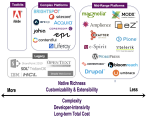Effective Migration and Rollout Planning
Enterprises often stumble with the migration and rollout phases of major replatforming initiatives.
Mostly this is due to a lack of planning, since we all have a tendency to put off migration and rollout planning until the very end. Alas, the very end is the worst time to do this, since changing the overall approach typically becomes nigh impossible. For longterm success, you want to start early.
Rollout plans look at how to move multiple divisions, offices, or sections from one system to another, in particular considering the optimal sequencing and streamlining. Migration planning looks more specifically at how the content should be handled when moving between systems. Whereas the implementation strategy is looking at what should be implemented and a broad trajectory forward, migration and rollout planning goes into more of the how to make the move.
Let's have a look at a couple of example plans.
Sample Migration Plan
An effective migration plan describes the following:
- How should “buckets” of content (for instance, all articles over two years old) be treated during the migration? What content can be deleted?
- What quality levels are we shooting for?
- What is the estimated effort level, and how will that estimate be refined over time?
- How do we track the progress of the migration?
A rough estimate of the effort level is a key element of a migration plan. This is often usefully broken down by the effort required per division and by content type:

Example Rollout Plan
A rollout plan describes the following:
- Can divisions, offices, or sections logically be grouped together from a rollout perspective?
- How should projects or sites be sequenced, and what functionality needs to be implemented when?
- How should different stakeholders be engaged throughout the rollout process?
- How can the rollout process be used to prime ongoing change processes post-launch?
Developing a rollout plan needs to include a simple high level sequencing chart. In addition to the grouping and ordering of components of the rollout (the rows below), it needs to specify when different groups will be working together (the colors below):

Real Story Group Can Help
RSG can help you create an effective migration and rollout plan. This includes developing an interactive inventory along with estimations in a tool that you can continue to tweak going forward. Contact us for more details.








